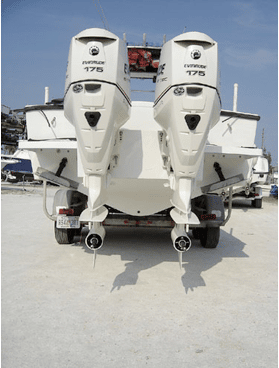
Outboard Repowering Options
I experienced the trials and tribulations of repowering firsthand with my last canyon-running charter boat, a 1981 Phoenix 27 Express that featured a classic outboard transom cutout. The critical issues I had to deal with back then are the same issues you will have to deal with now when approaching a repowering project, specifically how the new engines will affect your vessel’s range, cruising speed and center of gravity and where your cockpit and engine-well scuppers will be relative to your boat’s “revised” waterline.
When I purchased the Phoenix 27 back in 1997 as the third owner, she was deep into her second set of outboards. From documents I obtained from Phoenix prior to my purchase, the original owner bought the boat at the New York Boat Show outfitted with a pair of Evinrude 200s that weighed less than 400 pounds each. Owner No. 2 joined the Phoenix’s lineage eight years later in 1989 and replaced the original Outboard Marine Corp. engines with a pair of Yamaha 200 triple carb two-stroke outboards that tipped the scales at 415 pounds per engine. When I picked up the old girl in October 1997 as lucky owner No. 3, she had 800-something hours on the newer Yamis. I had no trouble selling those reliable workhorses to a New Jersey state trooper who drove to my house on Long Island and dropped them into the back of his pickup truck before heading back west into the sunset. As a Mercury Guide, my plan was to put a new set of 200s on the Phoenix’s transom every year, so she would have fresh power and I’d theoretically have one less thing to worry about running an older boat 90 miles offshore.
The first Mercs, a 1998 pair of triple carb Black Max 2.5-liter V-6 200s, tipped the scales at 405 pounds per motor, so there was no radical weight change on the transom transitioning from the Yamahas to the Mercs. The waterline stayed true, and both the twin cockpit scuppers and the trio of motor-well scuppers were a few inches above the briny as before. A typical 14-hour canyon day trip (seven running and seven trolling) was averaging a fuel burn of about 170 gallons from the Phoenix’s twin 100-gallon tanks and roughly 3.5 gallons of two-stroke oil, with a 25-knot cruising speed. The thin fuel reserve always concerned me, so for the next five years I ran pairs of Mercury 3.0-liter OptiMax 200 outboards. At the time, these direct-injection V-6s were a seismic paradigm-shifting upgrade in two-stroke power. The fuel burn on that same 14-hour canyon trip was now reduced to 127 gallons total (a whopping 25 percent improvement over the Black Max 200s at 170 gallons), and the outboards consumed 3.0 gallons of two-stroke oil and produced a faster 27-knot cruising speed … sweet! But there were a few challenges with the chunky OptiMax outboards. At 509 pounds each, they were a total of 208 pounds heavier than the Black Max 200s they replaced, and I was forced to both repaint my waterline higher and move two of the four marine batteries from the aft battery shelf compartment to a spot near the helm. The net 140-pound weight change on the transom lowered my scuppers a little bit closer to the waterline. This is not a big deal in the bay, but more of a concern when drifting in big offshore swells.
For 2004, 2005 and 2006, my desire to run four-strokes shifted me over to Suzuki DF225s, since these 55-degree 3.6-liter blocks were the only outboards that would fit on the Phoenix’s transom. At 600 pounds each, there would be an additional 182 pounds of net weight on the transom over the previous Mercs, and this was going to pose a real challenge. Once again the waterline had to be adjusted and the remaining two batteries migrated from aft to forward in an effort to reclaim the vessel’s original center of gravity. The cockpit scuppers were still at least 3 inches above the waterline, so I was good to go there, but while the trio of engine-well scuppers seemed OK in the bay, offshore was a different story, so I was compelled to add a trio of one-way rubber flaps over the outside of each scupper hole in an attempt to control the backflow of water into the outboard well. But the added weight aft made the transom a bit slower to recover when drifting in a following sea, and water would wash over the top of the transom and into the well, especially with three or four anglers standing in the back of the cockpit. Fuel economy for that 14-hour canyon trip was acceptable at 145 gallons (yes, the DI Mercs did get better fuel economy) and cruising speed was the same at 27 knots, albeit requiring me to push the four-strokes 300 rpm harder than the two-strokes to achieve it (4,300 rpm for the Suzukis versus 4,000 revs for the Mercs).
So what did I learn from all of this real-world experimentation? Upgrading to newer engines improved reliability, performance, speed and fuel economy as predicted. But the added weight of different types of fresh power also caused some center-of-gravity changes that adversely affected my boat’s self-bailing abilities until I was able to identify the problem areas and make the necessary adjustments to fix it. The Phoenix’s open layout and removable cockpit sole hatches allowed me to mix and match onboard components to address the weight issues. Yours may not allow this type of flexibility, so be advised.
For a chart of repowering options, click here.









